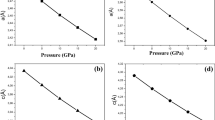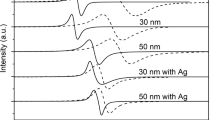Abstract
The magnetic anisotropy energy (MAE) of the bulk hcp Co under mechanical deformation is calculated by ab initio density functional theory (DFT) calculations based on the projector augmented wave method. We present a thorough investigation with respect to the choice of exchange-correlation functionals. The generalized gradient approximation (GGA) succeeds in predicting the easy axis of magnetization but underestimates the MAE in comparison to the experimental value, whereas the local density approximation gives a wrong magnetic easy axis. The DFT+ U method offers an alternative to increase the MAE value. Unfortunately, as the MAE reaches the experimental value, strong distortions of the lattice parameters are observed. Our results with GGA suggest that a simultaneous reduction of the c/a ratio and increase of the lateral lattice parameter a will strongly enhance the MAE of the material, as observed experimentally. We also found that the MAE in hcp Co is reduced by shear strain.






Similar content being viewed by others
References
D. Weller and A. Moser: Thermal effect limits in ultrahigh-density magnetic recording. IEEE Trans. Magn. 35, 4423 (1999).
C.H. Lee, H. He, F.J. Lamelas, W. Vavra, C. Uher, and R. Clarke: Magnetic anisotropy in epitaxial Co superlattices. Phys. Rev. B 42, 1066 (1990).
N. Inaba, A. Nakamura, T. Yamamoto, Y. Hosoe, and M. Futamoto: Magnetic and crystallographic properties of CoCrPt thin films formed on Cr–Ti single crystalline under layers. J. Appl. Phys. 79, 5354 (1996).
M. Futamoto, N. Inaba, A. Nakamura, and Y. Honda: Microstructures and basic magnetic properties of co-based epitaxial magnetic thin films. Acta Mater. 46, 3777 (1998).
T. Shimatsu, Y. Okazaki, H. Sato, O. Kitakami, S. Okamoto, H. Aoi, H. Muraoka, and Y. Nakamura: Large uniaxial magnetic anisotropy of Co–Pt perpendicular films induced by lattice deformation. IEEE Trans. Magn. 43, 2995 (2007).
G. Andersson and B. Hjörvarsson: Effects of strain on magnetic anisotropy in Fe-and Co-based heterostructures. Phase Transitions 81, 679 (2008).
T. Shimatsu, Y. Okazaki, H. Sato, H. Muraoka, H. Aoi, T. Sakurai, S. Okamoto, O. Kitakami, S. Tanii, and A. Sakuma: Uniaxial magnetic anisotropy in Co and Co–Pt based perpendicular films in relation to lattice deformation. J. Appl. Phys. 103, 07F524 (2008).
J-J. Wang, T. Sakurai, K. Oikawa, K. Ishida, N. Kikuchi, S. Okamoto, H. Sato, T. Shimatsu, and O. Kitakami: Magnetic anisotropy of epitaxially grown Co and its alloy thin films. J. Phys. Condens. Matter 21, 185008 (2009).
D.M. Paige, B. Szpunar, and B.K. Tanner: The magnetocrystalline anisotropy of cobalt. J. Magn. Magn. Mater. 44, 239 (1984).
G.H.O. Daalderop, P.J. Kelly, and M.F.H. Schuurmans: First-principles calculation of the magnetocrystalline anisotropy energy of iron, cobalt, and nickel. Phys. Rev. B 41, 11919 (1990).
J. Trygg, B. Johansson, O. Eriksson, and J.M. Wills: Total energy calculation of the magnetocrystalline anisotropy energy in the ferromagnetic 3d metals. Phys. Rev. Lett. 75, 2871 (1995).
M.S.S. Brooks: Calculated ground state properties of light actinide metals and their compounds. Physica B & C 130, 6 (1985).
O. Eriksson, M.S.S. Brooks, and B. Johansson: Orbital polarization in narrow-band systems: Application to volume collapses in light lanthanides. Phys. Rev. B 41, R7311 (1990).
S.V. Beiden, W.M. Temmerman, Z. Szotek, G.A. Gehring, G.M. Stocks, Y. Wang, D.M.C. Nicholson, W.A. Shelton, and H. Ebert: Real-space approach to the calculation of magnetocrystalline anisotropy in metals. Phys. Rev. B 57, 14247 (1998).
M.D. Stiles, S.V. Halilov, R.A. Hyman, and A. Zangwill: Spin-other-orbit interaction and magnetocrystalline anisotropy. Phys. Rev. B 64, 104430 (2001).
Y. Xie and J.A. Blackman: Magnetocrystalline anisotropy and orbital polarization in ferromagnetic transition metals. Phys. Rev. B 69, 172407 (2004).
T. Burkert, O. Eriksson, P. James, S.I. Simak, B. Johansson, and L. Nordström: Calculation of uniaxial magnetic anisotropy energy of tetragonal and trigonal Fe, Co, and Ni. Phys. Rev. B 69, 104426 (2004).
F. Ono and H. Maeta: Determination of lattice parameters in hcp cobalt by using x-ray bond’s method. J. Phys. Colloq. 49, 8 (1988).
G. Kresse and J. Hafner: Ab initio molecular dynamics for liquid metals. Phys. Rev. B 47, 558 (1993).
G. Kresse and J. Furthmüller: Efficient iterative schemes for ab initio total-energy calculations using a plane-wave basis set. Phys. Rev. B 54, 11169 (1996).
P.E. Blöchl: Projector augmented-wave method. Phys. Rev. B 50, 17953 (1994).
J.P. Perdew and Y. Wang: Accurate and simple analytic representation of the electron-gas correlation energy. Phys. Rev. B 45, 13244 (1992).
J.P. Perdew, K. Burke, and M. Ernzerhof: Generalized gradient approximation made simple. Phys. Rev. Lett. 77, 3865 (1996).
H.J. Monkhorst and J.D. Pack: Special points for brillouin-zone integrations. Phys. Rev. B 13, 5188, (1976).
S.L. Dudarev, G.A. Botton, S.Y. Savrasov, C.J. Humphreys, and A.P. Sutton: Electron-energy-loss spectra and the structural stability of nickel oxide: An LSDA+ U study. Phys. Rev. B 57, 1505 (1998).
A.E. Mattsson, R. Armiento, P.A. Schultz, and T.R. Mattsson: Nonequivalence of the generalized gradient approximations PBE and PW91. Phys. Rev. B 73, 195123 (2006).
I. Yang, S.Y. Savrasov, and G. Kotliar: Importance of correlation effects on magnetic anisotropy in Fe and Ni. Phys. Rev. Lett. 87, 216405 (2001).
R. Wu and A.J. Freeman: Spin–orbit induced magnetic phenomena in bulk metals and their surfaces and interfaces. J. Magn. Magn. Mater. 200, 498 (1999).
M.M. Steiner, R.C. Albers, and L.J. Sham: Quasiparticle properties of Fe, Co, and Ni. Phys. Rev. B 45, 13272 (1992).
J.P. Perdew, J.A. Chevary, S.H. Vosko, K.A. Jackson, M.R. Pederson, D.J. Singh, and C. Fiolhais: Atoms, molecules, solids, and surfaces: Applications of the generalized gradient approximation for exchange and correlation. Phys. Rev. B 46, 6671 (1992).
H.J.F. Jansen: Origin of orbital momentum and magnetic anisotropy in transition metals. J. Appl. Phys. 67, 4555 (1990).
J. Wang, J-M. Albina, and Y. Umeno. Ab initio calculation of strain effect on the magnetic properties of the thiogermanate [(CH3)4N]2FeGe4S10. J. Phys. Condens. Matter. 24, 245501 (2012).
M. Cerný, J. Pokluda, M. Šob, M. Friák, and P. Šandera: Ab initio calculations of elastic and magnetic properties of Fe, Co, Ni, and Cr crystals under isotropic deformation. Phys. Rev. B 67, 035116 (2003).
S. Ogata, Y. Umeno, and M. Kohyama: First-principles approaches to intrinsic strength and deformation of materials: Perfect crystals, nano-structures, surfaces and interfaces. Modell. Simul. Mater. Sci. Eng. 17, 013001 (2009).
M. Friák, M. Šob, and V. Vitek: Ab initio calculation of phase boundaries in iron along the bcc-fcc transformation path and magnetism of iron overlayers. Phys. Rev. B 63, 052405 (2001).
T. Shimada, Y. Ishii, and T. Kitamura: Ab initio study of magnetism at iron surfaces under epitaxial in-plane strain. Phys. Rev. B 81, 134420 (2010).
E.G. Moroni, G. Kresse, J. Hafner, and J. Furthmüller: Ultrasoft pseudopotentials applied to magnetic Fe, Co, and Ni: From atoms to solids. Phys. Rev. B 56, 15629 (1997).
D. Bagayoko and J. Callaway: Lattice-parameter dependence of ferromagnetism in bcc and fcc iron. Phys. Rev. B 28, 5419 (1983).
Y. Honda, H. Funamono, S. Hasegawa, T. Kawasaki, F. Kugiya, M. Koizumi, K. Yoshida, and A. Tonomura: Recorded magnetization patterns of highly c-axis oriented Co-Cr film observed by electron holography. J. Phys. Colloq. 49, C8–C1969 (1988).
J.P.C. Bernards, C.P.G. Schrauwen, and S.B. Luitjens: Single-layer and multilayered films for perpendicular recording based on a Co-Cr alloy. Appl. Phys. A 49, 491 (1989).
J. Xu, M. Furukawa, A. Nakamura, and M. Honda: Mechanical demagnetization at head disk interface of perpendicular recording. IEEE Trans. Magn. 45, 893 (2009).
Acknowledgments
The present work was partly supported by the GMSI (Global Center of Excellence for Mechanical Systems Innovation) program at the University of Tokyo: A GCOE (Global Center of Excellence) program by Ministry of Education, Culture, Sport, Science and Technology (MEXT). J.W. gratefully acknowledges the MEXT scholarship program.
Author information
Authors and Affiliations
Corresponding author
Rights and permissions
About this article
Cite this article
Wang, J., Albina, JM., Iwasaki, T. et al. Influence of normal and shear strain on magnetic anisotropy energy of hcp cobalt: An ab initio study. Journal of Materials Research 28, 1559–1566 (2013). https://doi.org/10.1557/jmr.2013.149
Received:
Accepted:
Published:
Issue Date:
DOI: https://doi.org/10.1557/jmr.2013.149




